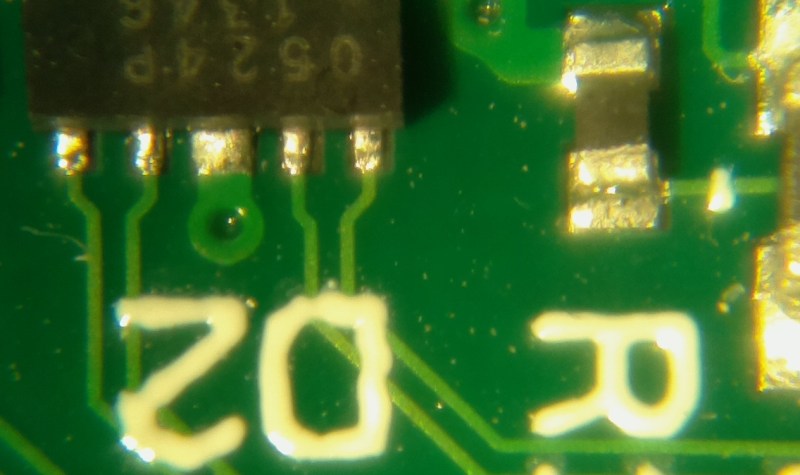Fortunately (or unfortunately), [ucDude] has had the opportunity to try out a high quality video microscope while soldering some small surface mount components. He loved it, the problem was he had a hard time going back to using just his eyes. He wanted a video microscope but the cost for a professional one could not be justified. The solution? Build one!
[ucDude] called on one of his photographer friends to help. After discussing the project they decided to use a webcam and a lens from an SLR camera. Testing with the webcam resulted in an image that could not be zoomed-in enough, plus having to connect it to an external computer proved to be a bulky solution. They next tried a Raspberry Pi, camera module and zoom monocular. It worked great! The entire assembly was then mounted to a camera boom stand making it easy for the camera to be positioned over the work area and out of the way of hands and soldering irons. The Raspberry Pi’s HDMI output is plugged straight into an HD monitor. The result is exactly what [ucDude] was looking for. Now he can quickly and confidently solder his surface mount circuit boards.

















What a sharp idea… ;^)
A new way of looking at things. :)
Focus people.
I see what you did there.
Look, Look people, clearly we see plently of microscopic jokes which focus on the components of the article, but …
thats all I can think of.
I like this, but im going to try and make one with my USB microscope, I can see these are going to be handy!
This also works quite well, and was reviewed by the EEVblog as well. :)
http://www.ebay.com/itm/200994145191?_trksid=p2059210.m2749.l2649&ssPageName=STRK%3AMEBIDX%3AIT
I use with my Windows PC, but it could probably be run from a Raspberry Pi as well.
That seems fairly expensive for something without any sort of focusing lense and only 2MP I mean I don’t think. Whats the image quality and lighting like?
Way cheaper on chinese sites like DX and aliexpress
DealExtreme customer service is a sad, sad joke. Don’t even bother. If they send the wrong item, just throw it away and try again. You can and will waste hours and hours of your life dealing with these people and in the end you will just get screwed anyway.
odd, the time i had a problem (never received after weeks), they just sent me another one, with no questions/hassle. a week later i got the original one. i emailed them thinking they could still cancel the replacement, they told me to not worry about it and keep both. *shrug*
by “works quite well” he means jello and laggy as shit
I can do really fine work and quickly with a stereo microscope. Can’t solder fine parts worth a damn with mono.
I always wondered how those super-villains with the eye patches always managed to do field repairs on their radios in the jungle with a pack of matches and a paper clip.
I have been trying to make something like this for ages. Unfortunately I don’t know anything about optics and lenses.
I have poor sight and it’s hard for me to even work with 0.1 inch type components. At the moment, I work from memory and feel. Then a take a picture with a digital camera and see my mistakes on a monitor. Fix the mistakes, repeat, repeat … it’s a very slow process.
I have tried reversing the lens on a web cam. Recently I tried using the lenses from a laser diode enclosure and that was a bit better because it could be further away but it had very limited focus.
If only I could find the right combination of (motion) camera module and lenses.
I’ve had great success with a cheap plastic head-mounted stereo magnifier, the one with the lens on a pivot. The strap that clamps around your head is not very comfortable, but I padded it with some tape and now it’s fine. With these I can easily solder TQFP parts on 0.5 mm spacing. I was bummed out when the Beatles broke up, that’s how old I am.
However the thing that really makes the difference is the lighting. If you go with just one light source then you are going to have lots of problems with shadows. To really see what is happening, you need multiple diffuse light sources so you don’t get shadows. I got a couple of cheap desk LED lamps and they work great.
The other thing that’s necessary is a tiny fan to blast the nasty soldering fumes away from your face.
This is a nice hack but you’ed think you could do the same thing with a jewellers loupe, for me some robotic “hand” to keep the iron steady would be better.
With a jeweler’s loupe, the lens has to be approximately 3in from the observed surface in order to be focused which would likely lead to the soldering iron hitting the lens. One needs a setup with the lens farther away from the surface.
My typical technique is to solder without magnification, then inspect with a 10x or 20x jeweler’s loupe. But I have pretty good vision (at least at that that distance).
I’ve been soldering with a plastic loupe for decades now and I’ve never had the soldering iron come in contact with the lens. Fingers, clothes, antistatic mat, DVM probes, even my pliers, they all have soldering iron scars, but my magnifier has none at all.
While I think this is a clever build and would have parts that will be useful to other users, for the immediate application I use a USB microscope (~US 35 – US$85 on Amazon, probably cheaper elsewhere) and think that playing a bit with the optics from there if necessary for distance (mine seems just fine). The image processing etc. is already in place and they usually have a ring-light assembly to help with close work.
I tried one of those and the lag was just awful, on the order of a whole second. It’s nice for post-soldering inspection but the lag makes it impossible to use for interactive work.
They have versions of these that are PAL and/or NTSC-out that don’t lag as much as the USB versions.
Just make sure you get one from Aliexpress from a seller that says that they’re NTSC/PAL, when in fact they’re only PAL. Makes your day (month).
I’m not too familiar with the Rasberry Pi camera. How is the latency? The last time I played with soldering SMT parts using a PC connected microscope, the lag was driving me crazy!
Surprisingly there’s no latency to speak of when you connect the screen directly to the RPi as there’s no CPU involved, the camera output goes directly to GPU to HDMI output. Now if you want to save or stream the data then grab a coffee…
Good to know, thanks!
I wrote an Android app to do this. It works surprisingly well.
I use the camera on my smart phone all the time to take very close up pictures of circuits. Mainly for documenting component failures. There are free camera apps out that give you a manual focus. All you need is something to hold the phone to free up your hands. Although, I don’t use it to solder.
Actually depending on what you want to do you don’t need any additional hardware, the lens focus is set to infinity by default, but by turning it gently you can break the glue and set it as close as you want (source: I’ve done it). Here’s an official video on how to it: http://www.raspberrypi.org/macro-photography-with-the-camera-board/
I have been using an Elmo Video Presenter (from Ebay) for a few years now. The best purchase I have made. With this device, I can solder 0.4mm pitch ICs ok.
Been there, tried that. Camera microscopes are just a bad joke, no matter how “professional” they are.
A screen image have lag, small definition, flicker, no spatial view, etc. The idea simply doesn’t work.
After you will look into a stereo _optical_ microscope for the first time, you will do everything to get one.
There is no camera like a stereo optical microscope.
Simple statement…. video microscopes are complete crap.
Don’t ever waste your money on one.
Biggest problem is that you loose all depth of vision, a standard stereo optical microscope is decades ahead of anything with video…. when working at this level you need stereoscopic vision
Stereoscopes are the solution here. Had an extremely expensive one with a ring light when I worked at TI, and after leaving TI, I bought my own on eBay for about $100 delivered. It had no ring light or platform, but I replaced those with a high-power LED flashlight and a small cutting board from the dollar store. Works great for SMT work, and even for the tiny splinter I removed from my thumb yesterday… :)
As stated by others, I had also tried a USB microscope, but the lag is intolerable….